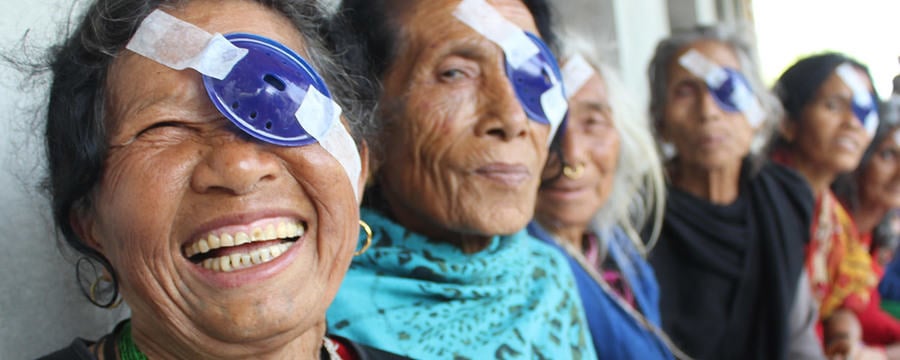Setting targets

Share this step
In step 5.9 we introduced the concept of targets. We now ask you to read and reflect on the following guidance, looking at the type and sources of information that may be necessary to set targets for the planning of cataract or refractive error services at the district level.
This article is adapted from: Using evidence for VISION 2020 “district” planning. Kilimanjaro Centre for Community Ophthalmology, 2009.
Information needed to plan for cataract services at district level
Population distribution (% of population age 50+)
Information source: Census
Information use: To determine the potential number of people affected
Cataract surgical rate (CSR)
Information source: Cataract Surgical records at all hospitals in the district.
Information use: CSR can be calculated and this can help identify output. Ideally to address cataract blindness a CSR of 2000 is required.
Productivity of surgeons
Information source: If there is more than one surgeon in the district, the total number of surgeries can be divided by the number of surgeons or monitor productivity for each surgeon individually.
Information use: To measure whether desired levels of productivity are being reached. (Surgeries per surgeon per week)
Surgical outcomes
Information source: Hospital records on post surgical visual outcome Information use: Measure of quality of service and reasons for poor quality.
Prevalence of cataract
Information source: Survey or, if not available, use estimates from nearby, similar areas.
Information use: To determine number of people affected by cataract for use in advocacy, e.g. fundraising.
Cataract surgical coverage (CSC)
Information source: Survey or, if not available, use estimates from nearby, similar areas.
Information use: To determine the proportion of people at different visual cut-offs who have received services. A CSC of 75-85% or higher would be considered good coverage. Assessing the relative CSC separately for men and women helps identify gender inequity.
Type of surgery, location of service provision, geography of the area, etc.
Information source: Stakeholders
Information use: Level of static or outreach can inform on changes required cataract surgery provision.
Price and cost of surgery
Information source: Stakeholders and discussions with patients will reveal the price. Cost can be determined by analysing hospital financial records.
Information use: Helps to assess if price is a barrier to surgery. Comparing the price with estimated cost helps to identify the potential level of cost recovery and support needed for the programme.
Case finding options
Information source: Stakeholders and communities.
Information use: Identify practical strategies to find cataract cases.
Definition of vision for operation (vision cut off)
Information source: Stakeholders.
Information use: To help determine the amount of surgery to set as a target.
Case mix
Note: This is the percentage of people with vision at various levels prior to surgery
Information source: Pre-operative visual acuity from hospital records.
Information use: Case mix should provide similar estimates on how many blind cases are operated.
Barriers to use of cataract services
Information source: Focus group discussions and in-depth interviews with community or patient groups. Great variation may exist between different locations.
Information use: Used to redesign how to improve use of services. Key barriers are poor awareness, poor access, and poor acceptance.
Information needed to plan for refractive error services at district level
Number of people age 40+
Information source: Census.
Information use: Estimate of the potential number of older people.
Prevalence of presbyopia in people age 40+
Information source: Survey findings.
Information use: To calculate the potential number of presbyopic people.
Number of children age 11-15 years and number enrolled in schools
Information source: Census info and Ministry of Education.
Information use: To estimate the number of children in this age group.
Prevalence of refractive errors in children 11-15
Information source: Survey findings (see above for best estimates).
Information use: Main target for providing spectacles. Around 5% of these children will need spectacles.
Barriers and cultural attitudes to wearing spectacles
Information source: Focus group discussions and in-depth interviews can be used to assess barriers.
Information use: This information further refines estimates of how many spectacles need to be provided.
Number of spectacles provided in past year
Information source: Records where spectacles are dispensed (data from private opticians difficult to collect).
Information use: This may serve as a baseline in order to establish targets for service delivery in the plan. It should also be used to monitor service provision, and- to be most useful it should include all the service providers in the district.
National policy on spectacle dispensing
Information source: Ministry of Health.
Information use: All stakeholders and providers need to be aware of this before starting services.
Service providers, location, type of providers
Information source: Stakeholders.
Information use: Knowing where spectacles and refraction can be obtained will help planners decide on strategies to adopt. It is important to know if government eye care providers use spectacle sales to generate extra income.
Price of spectacles and cost for obtaining spectacles
Information source: Services that dispense spectacles.
Information use: Allows planners to assess the level of cost recovery and sustainability achieved through spectacle sales.
Discussion
How much of the information listed above do you think you could find in your own setting
Share this
Global Blindness: Planning and Managing Eye Care Services

Global Blindness: Planning and Managing Eye Care Services


Reach your personal and professional goals
Unlock access to hundreds of expert online courses and degrees from top universities and educators to gain accredited qualifications and professional CV-building certificates.
Join over 18 million learners to launch, switch or build upon your career, all at your own pace, across a wide range of topic areas.
Register to receive updates
-
Create an account to receive our newsletter, course recommendations and promotions.
Register for free







